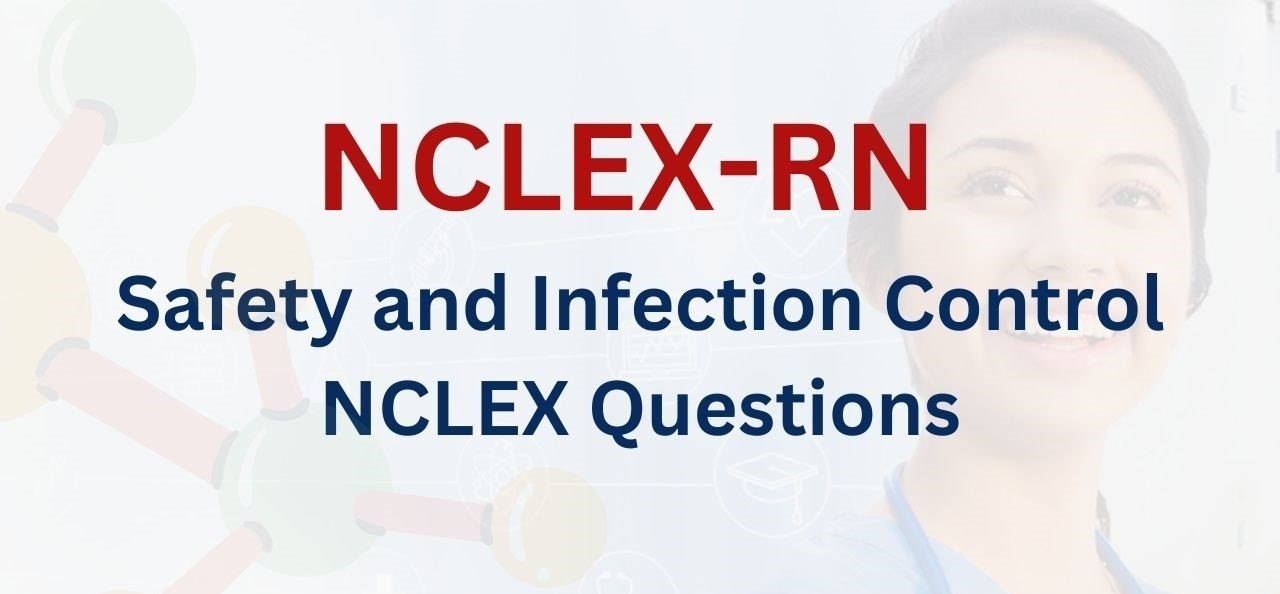NCLEX RN infection control questions
NCLEX practice items on infection control are paramount questions in the nursing licensure exam. Based on the NCLEX-RN exam, up to 15% of the questions will test the candidate’s competency in safety and infection control. It’s an important topic that helps nurses protect patients from environmental hazards. NCLEX RN infection control questions are vital in preparing for this area.
Naxlex a world-leading test preparation resource provides a carefully curated database of NCLEX RN infection control questions to prepare you for the exam. Client safety and infection control are crucial aspects of quality nursing care. Preparing for infection control questions is easy with Naxlex practice questions. Sign up for our infection control guides for guaranteed A in NCLEX.

Concepts explored in the NCLEX RN infection control questions
Throughout the nursing school and NCLEX test, you will need to master the content about infection control to provide holistic nursing care to patients. Knowledge and skills about infection control not only protect your patient but also yourself from infection. A great resource that can empower you to grasp this topic is the NCLEX RN infection control questions.
Safety, infection control, and precautions form a big part of the NCLEX. To pass the nursing licensure test, you’ll need to understand the basics of infection control including; airborne, droplet, contact, enteric, and neutropenic precautions. This knowledge is useful especially when you want to keep your clients safe within a clinical environment.
It is crucial to understand what infections can be contracted through contact, droplets, airborne precaution, personal protective equipment (PPE), and all other considerations relevant to a particular client. Safety and infection control concepts are adequately explored in the NCLEX RN infection control questions for effective preparation of the exam.
Knowing how to put on and take off PPE is an important skill as guided by the Centers for Disease Control . The following are summarized precautions for actual life nursing care for NCLEX to keep patients safe. These concepts are well addressed in the NCLEX RN infection control questions.
Sequence of infection
Knowing the sequence of infection is crucial to help nurses determine the points where interventions can break the cycle and prevent diseases from spreading. The sequence of infection comprises six links.
-
Infectious material or agent . This is the material or pathogen responsible for the infection. It can be some bacteria, viruses, fungi, or parasites.
-
Reservoir . This is the resource where the infectious material resides and reproduces. This can be infected organs or other parts of the body.
-
Portal of exit . It’s the pathway through which the infectious agent leaves the reservoir host such as; respiratory secretions, blood, or bodily fluids.
-
Mode of transmission . It’s the mechanism by which the pathogen is transferred from one host to the other. This includes direct or indirect droplet, airborne, or vector-borne transmission.
-
Portal of entry . The route to which the pathogen enters the host for instance; mucous membranes, respiratory tract, gastrointestinal tract, or broken skin.
-
Susceptible host . It’s an individual who is at risk of infection due to factors such as low immunity, invasive procedures, or underlying health conditions.
By comprehending each link in the sequence of infection, nurses can implement appropriate nursing interventions to address infection transmission and protect patients and other healthcare teams. The NCLEX RN infection control questions are important guides in this area.
Standard precautions
Standard precautions are foundational infection control interventions that apply to all patient care regardless of suspected or confirmed infection status. Key components of standard precautions are;
-
Hand hygiene . Washing hands with water and soap or using alcohol-based hand sanitizers before and after patient contact is paramount. It’s also important to wash hands after removing gloves or touching blood, body fluids, or contaminated items.
-
Personal Protective Equipment (PPE) . Use of PPEs such as; gloves, gowns, masks, and eye protection materials is recommended for safe nursing care.
-
Respiratory hygiene . Respiratory hygiene or cough etiquette such as covering the mouth with a piece of tissue or elbow when sneezing or coughing is paramount when interacting with the patient’s other healthcare team members.
Transmission-based precautions
Transmission-based precautions are extra infection control interventions used for clients with known or suspected infections that are transmitted by specific routes. Some of the potential transmission precautions include;
-
Contact precautions. They are used for infections spread by direct or indirect contact with the patient or their environment such as; MRSA and Clostridium difficile.
-
Droplets precautions . They are used for infections spread by large respiratory droplets e.g. influenza, pertussis, etc.
-
Airborne precautions . They are used for infections spread by small particles that remain suspended in the air and can be inhaled e.g., tuberculosis, measles, etc.
The precautions applied in nursing facilities comprise specific PPE and environmental controls to prevent the transmission of pathogens to other patients, visitors, and healthcare personnel. Utilizing NCLEX RN infection control questions can be a powerful resource for NCLEX preparation.
Environmental controls
Maintaining a clean and safe healthcare environment is paramount in preventing healthcare-associated infections. Some environmental control mechanisms include;
-
Cleaning and disinfection ; routine cleaning and disinfection of patient care equipment, environmental surfaces, and frequently touched items such as door knobs using appropriate disinfectants.
-
Isolation practices . Placing patients with particular infections in private rooms or combining those with the same infections to prevent transmission.
Effective environmental controls minimize the risk of cross-contamination and reduce the spread of infections within healthcare settings.
Education and communication
Education and communication are integral to infection control interventions. Nurses play a central role in educating patients, families, and healthcare personnel about infection prevention strategies including; hand hygiene, respiratory etiquette, and proper use of PPEs. Efficient communication promotes adherence to clinical safety within healthcare establishments.
Final word
Safety and infection control is a cornerstone piece of NCLEX RN infection control questions. Nurses must demonstrate their competency in understanding the sequence of infection, standardizing transmission precautions, maintaining safe environmental controls, and educating people about infection control mechanisms. By understanding these crucial topics and concepts, nurses will contribute to reducing healthcare problems associated with infection control. NCLEX RN infection questions are potent resources to guide you toward NCLEX success. If you want a high-quality test preparation resource that guarantees an A in the exam, try Naxlex today .
Start your journey with us today
Join 1000+ Nursing Students
Powerful learning and clinical tools combined into one platform. The Naxlex Knowledge and Qbanks give you instant and on-the-go nursing knowledge and guidance.




